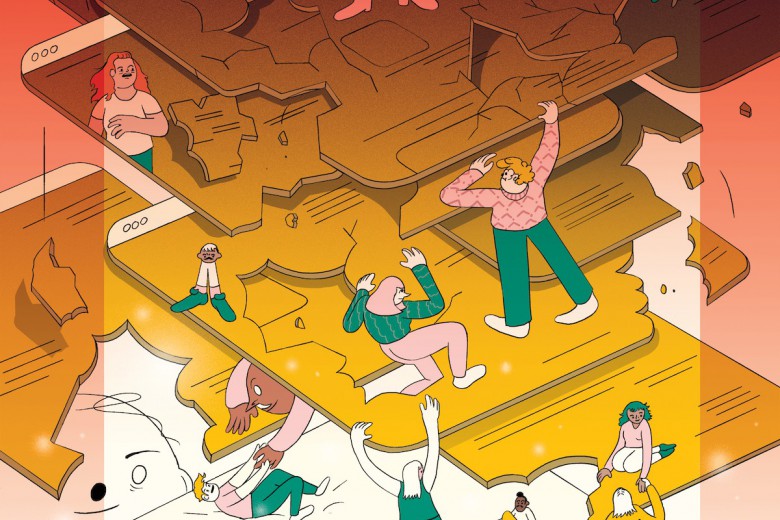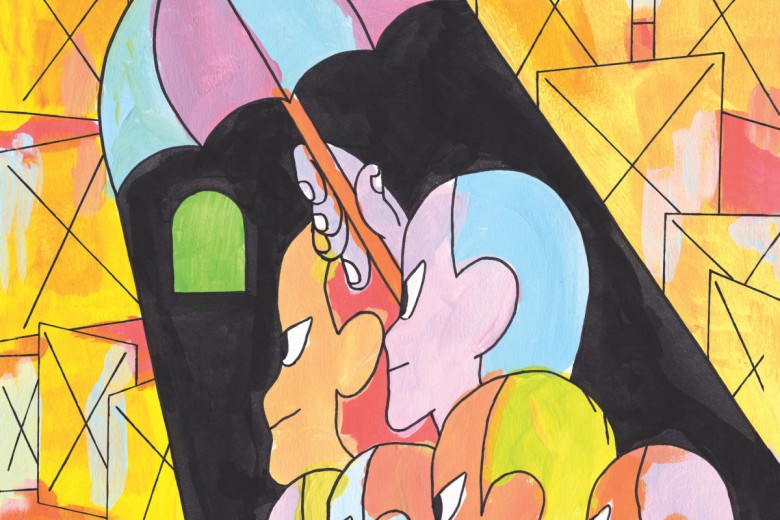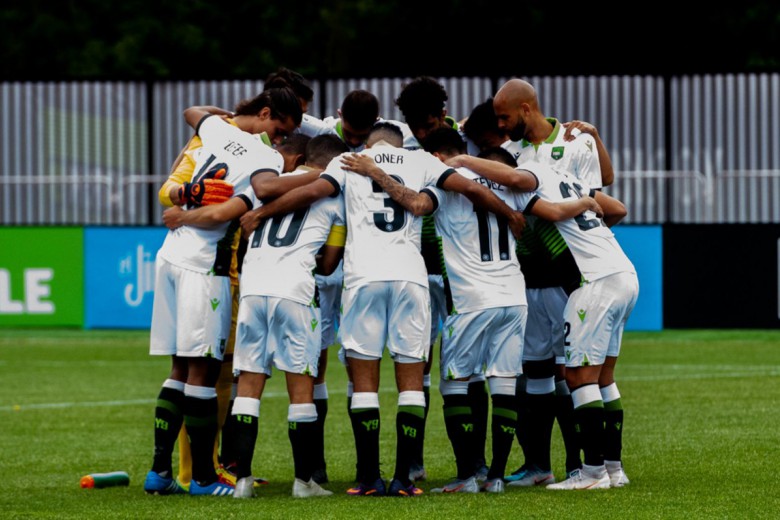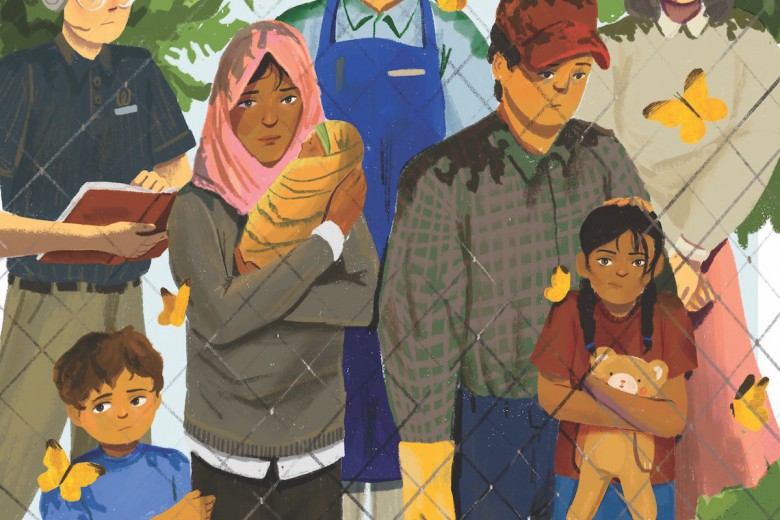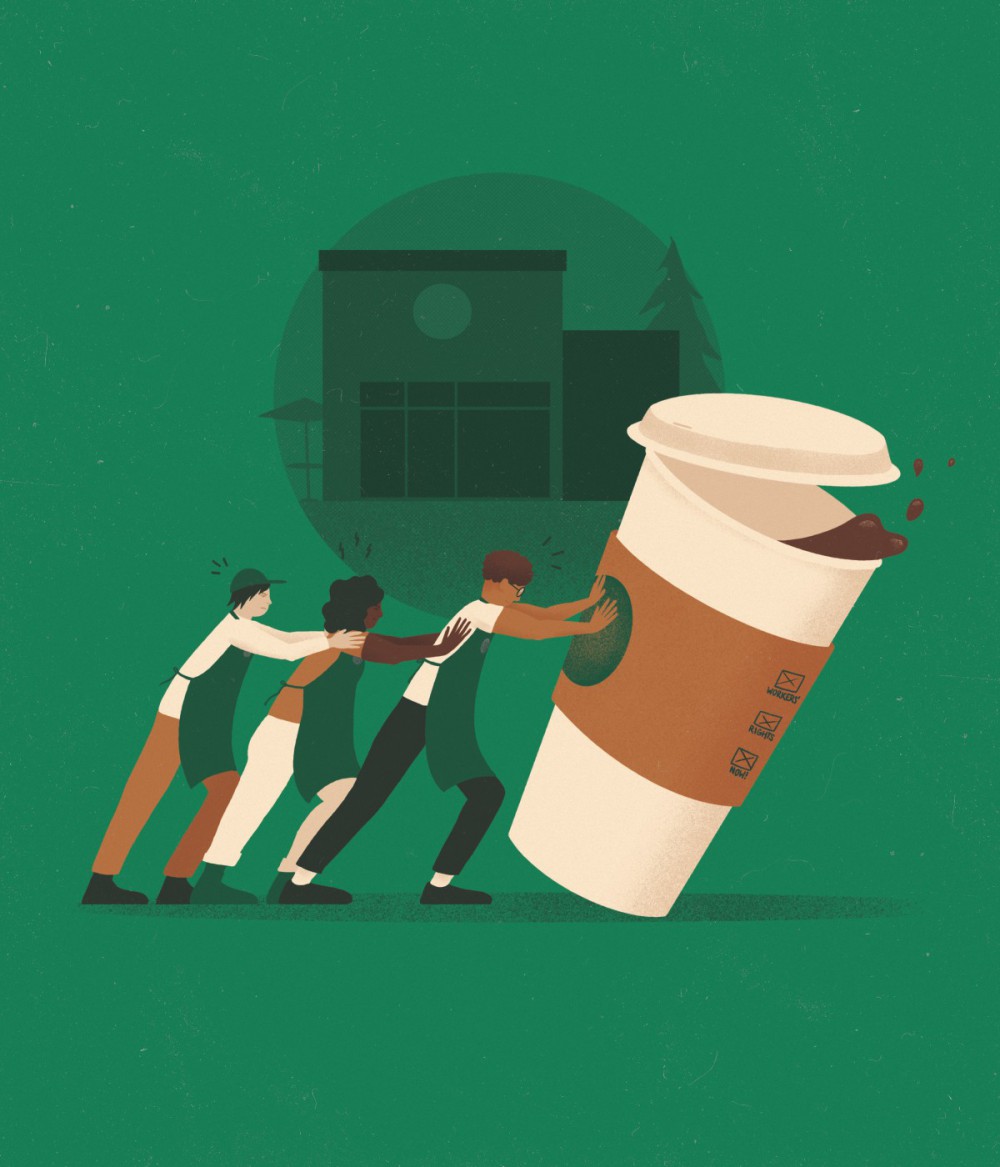
Robin Richardson-Dupuis
During the deadly first wave of the COVID-19 pandemic, Izzy Adachi was working at the Douglas Street Starbucks in Victoria, B.C. “We started noticing how rapidly things changed. We started getting called ‘essential workers’ when none of us had thought of our jobs as all that ‘essential.’”
So-called “hero pay” was introduced. Health and safety, however, seemed to come second to customer service. Feeling the personal protective equipment (PPE) provided by Starbucks was inadequate, workers like Adachi, or “partners,” as the company calls them, took to bringing their own PPE to work – a practice that managers at her store stopped. Then, without consulting workers, the company stopped its pandemic bonus pay.
According to Adachi, previous talk about unionizing suddenly revived with new urgency and seriousness. Seeing how quickly the employer could revoke benefits highlighted for workers their lack of control on the job. “We realized that this company wasn’t there to protect us as ‘partners.’ It was concerned to protect Starbucks and its image,” she explains.
“If we want to have coffee shops in our society, then we’re going to need baristas, and baristas should be working for fair pay and in safe conditions. They should be able to lead a life with dignity and respect.”
In August 2020, Douglas Street became the first unionized North American location of the coffee corporation since stores represented by the Canadian Auto Workers decertified in the mid-2000s. Workers in Victoria managed to certify with the United Steelworkers more than a year ahead of their counterparts in Buffalo, New York, who formed a union and set off a wave of organizing in the United States under the banner of Starbucks Workers United.
Starbucks is infamous for its animosity toward unions. The company’s seemingly congenital anti-unionism has for the past two years been on public display south of the border, where weak labour laws give employers wide latitude to oppose and combat organizing drives.
But the war on workers doesn’t end after the union is certified. Each store-level battle in the company’s anti-labour crusade typically extends from the organizing to the bargaining phase – that is, if workers ever manage to sit down with Starbucks for contract talks.
Consequently, while over 350 Starbucks locations in the United States have unionized, not one has achieved a collective agreement.
Things are somewhat different here in Canada. Relatively stronger provincial labour codes mitigate the most egregious types of union busting, intimidation, and endless delay for which Starbucks is notorious.
Even with these protections, however, negotiating a first contract with the coffee corporation has posed significant challenges. How to get Starbucks to take bargaining seriously and how to secure good collective agreements for workers over the long term therefore remain pressing issues.
“This is about wages and health and safety”
Union organizing can be a risky endeavour, even with Canada’s marginally better labour law regime. In most instances, evading management early in the process is key to success.
As Adachi recounts, “we were able to get cards signed and submitted without management knowing. They found out when they got a call from the Labour Board saying, ‘hey, your employees have filed to unionize.’ She [Adachi’s manager] thought it was a scam. She didn’t believe that this was possible or legal.”
In Frédérique Martineau’s case, unionizing her Starbucks store earlier this year was somewhat of an entrepreneurial endeavour. The organizing campaign at the Dunbar Street location in Vancouver was self-initiated. “I just Googled which union Victoria had gone with. I did some research on them and was like ‘okay, the Steelworkers are a good choice.’” She reached out to a union representative, who told her to form an internal workplace committee. “This was my inside committee. Just me,” she jokes.
Frédérique Martineau in front of the Starbucks she worked at and organized on Dunbar Street in Vancouver. In September 2023, months after workers unionized, the company announced it was shutting down the store. Photo courtesy of Frédérique Martineau.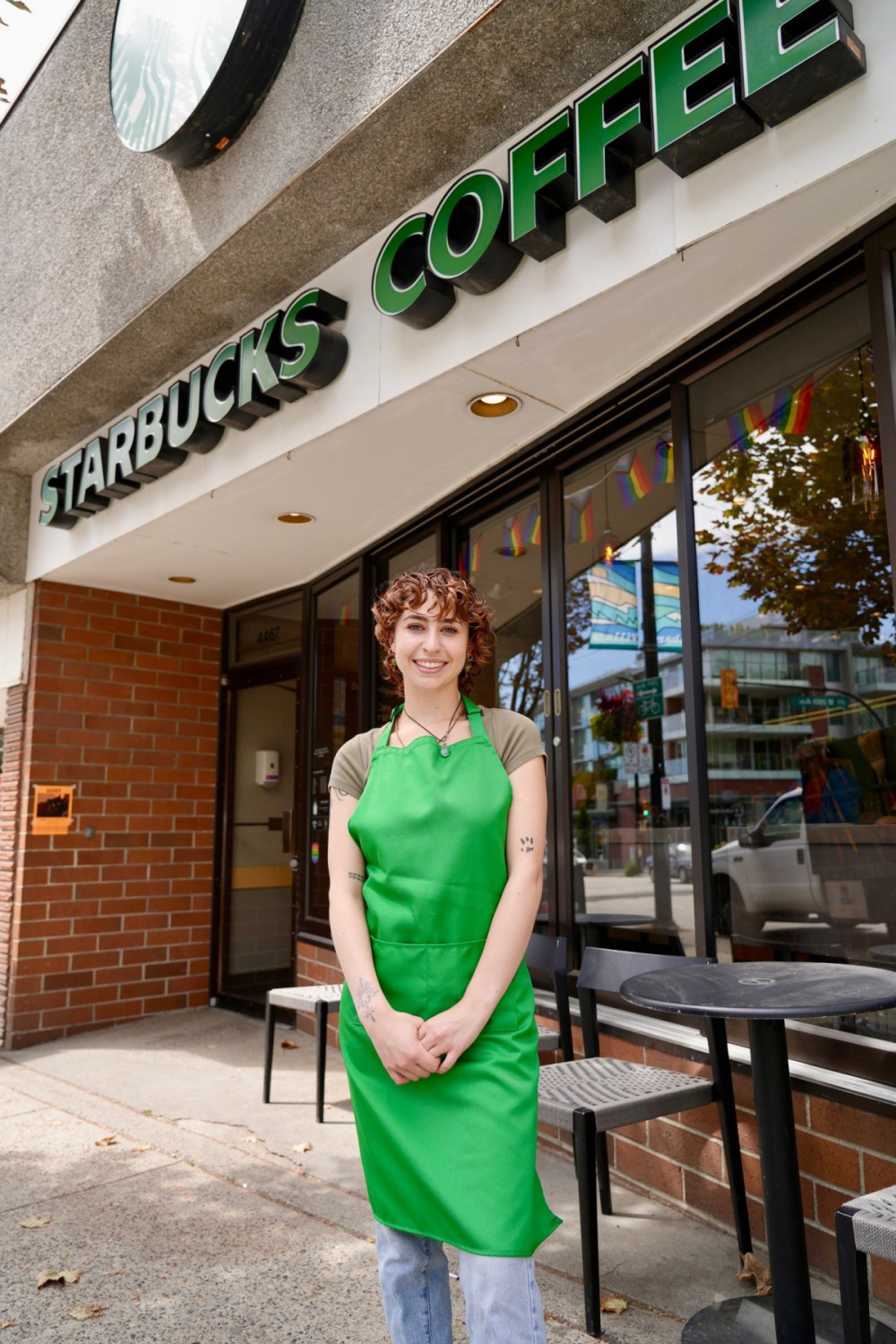
At both stores, after the company learned that workers were seeking union certification, workers’ grievances that Starbucks had let fester for weeks or months were miraculously addressed.
For example, in Victoria, Adachi explains that managers suddenly began to take health and safety more seriously. Instead of preventing workers from wearing extra PPE such as face shields, Starbucks issued company-approved masks.
But Starbucks also sent consultants and other high-level staff to Douglas Street to persuade workers to vote “no” in the upcoming certification vote. Company personnel even arrived from Starbucks Canada’s corporate headquarters in Toronto despite pandemic restrictions. Apparently attempting to break a union was considered “essential work” necessitating cross-country air travel.
The effort to halt the union drive in Victoria didn’t have the same no-holds-barred character as similar operations in the U.S., however.
“There was a lot of watching,” Adachi recalls. “They’d ask, ‘what if we moved this machine a bit to the left, would that make your work easier?’ And we’d be like, ‘no, this is about wages and health and safety.’”
Workers at Dunbar Street organized their union after the provincial NDP government reinstituted card-check certification. In their case, workers signed digital cards, and as Martineau recalls, “once we had around 80 per cent support, we just submitted our application, and that was it.”
“The biggest change was that we have the USW in our corner. You know that you’re not going to get bullied by your manager because you’re always gonna have your shop steward in your corner or your union [representative] is gonna come out and support you.”
The workers didn’t have to wait for the Labour Relations Board to hold a vote, giving Starbucks much less time to mount an anti-union counteroffensive or to encourage them to vote “no.” This is one example of how card check has made unionizing easier in British Columbia. According to the B.C. Labour Relations Board’s 2022 annual report, card check reduced the average time it took the Board to certify a union from 30 days to just eight.
Still, a similar pattern emerged in the brief window before the workers at Dunbar Street got their union certification. “That wire that was sitting in water and shocked seven people that management said they couldn’t fix, suddenly that’s fixed,” Martineau sarcastically recounts.
Despite some minor changes, however, many other things stayed the same. Customer abuse continued. Pay remained low. Management still held the power.
In other words, Starbucks’ attempts to pre-empt the union by superficially addressing long-standing grievances fell flat. According to both Adachi and Martineau, workers at their stores had begun to understand that a union contract was the only way to guarantee benefits and have a say over their pay and working conditions. And once workers at both stores had overwhelmingly decided to unionize, managers’ shallow efforts at ameliorating working conditions dropped off.
In preparation for bargaining, it seemed that the company had retreated and was preparing more formal resistance. Getting Starbucks to the table would prove to be a battle all its own.
“It’s a mind game”
What’s it like to collectively bargain with the largest coffee shop chain in the world?
“Bargaining with Starbucks is like when you break up with someone and they leave their stuff at your house,” Martineau half-jokes. “You text them, ‘hey, I’ve got your stuff, come pick it up.’ They say they’re going to come Tuesday afternoon, and they don’t show up. You reschedule, and again, they don’t come. And at that point, you’re like ‘do I just throw this stuff out or do I keep it?’ That’s what it’s like trying to bargain with them. They schedule meetings and they don’t show up. In part, I think it’s because they know the stores have high turnover, so if they wait, maybe new hires will vote to decertify [the union].”
There are now nine unionized Starbucks locations in Canada, but only Victoria and one location in Calgary have managed to secure collective agreements thus far.
The Douglas Street location bargained its contract in the shadow of COVID-19. Workers at the store were only able to meet with Steelworkers representatives once before negotiations with the company began. Collective bargaining with Starbucks took place infrequently and entirely over Zoom.
“It would be, like, once or twice a month, maximum. That’s what Starbucks would give us to bargain. So it took eleven months for us to get a contract,” Adachi explains in frustration. Securing a collective bargaining agreement ultimately required third-party mediation, an option the B.C. Labour Relations Code provides to unions facing an obstinate employer.
At Dunbar Street, talks progressed slowly and then broke off. In the weeks after Martineau and I spoke, Starbucks announced its intention to shutter the Dunbar Street location, citing a “natural lease expiry.” The company could plausibly deny that the closure had to do with workers unionizing, but it’s a difficult pill to swallow.
“Other stores trying to unionize are dealing with more pressure and intimidation. Most Starbucks locations now have a poster in their break room talking vaguely about the Douglas Street contract or saying ‘a union card is a legally binding contract,’ just trying to make unionizing seem scary.”
Unsurprisingly, bargaining contracts across multiple locations have been less than straightforward. According to Martineau, Starbucks prevented her store from joining with two other unionized B.C. stores under one collective agreement. “Starbucks wants every store to have its own contract, which makes bargaining take forever because they have one lawyer doing it,” she says.
Starbucks hasn’t exactly been consistent with how it believes unionized stores should relate to one another. The company’s insistence that unionized stores bargain separately contrasts with its past attempts to force multiple U.S. stores to vote together during certification. In these latter cases, Starbucks has tried to defeat unionization votes by including workers at stores who haven’t been organized by the union. Yet when greater numbers of workers wish to come together across stores for the purpose of bargaining, the company treats its locations as islands unto themselves.
The company’s divide-and-conquer approach hasn’t stopped workers at unionized stores from coordinating their bargaining preparation. As Martineau explains, “there might be some small changes that don’t work for my store but work for others. If we can agree on some stuff, like base language, we’ll do that, because then it makes bargaining easier later.” In this way, workers at different stores can collectively come together around bargaining priorities while still maintaining autonomy and flexibility.
Getting a seat at the bargaining table with Starbucks can also be challenging for mundane reasons. For instance, workers on the bargaining committee need to be off work when negotiations are scheduled. As Martineau explains, this seemingly opened a new terrain of avoidance and sabotage for the company. “When we have bargaining, HR is supposed to tell our manager, ‘okay, these two girls have bargaining on Monday.’ But then they’ll schedule us to work, so if I go to bargaining, I miss my shift.”
After she confronted her manager about it, the “problem” was corrected. But little roadblocks like this accumulate and add frustration to the bargaining process.
“I think it’s a mind game,” she adds.
“It’s almost like we’re sectoral bargaining, but we’re not”
The contents of the Douglas Street collective agreement remain a subject of debate, something the company has seized upon.
After workers in Victoria ratified their contract, Starbucks integrated negative talking points about the collective agreement into its roving anti-union campaign. “Other stores trying to unionize are dealing with more pressure and intimidation. Most Starbucks locations now have a poster in their break room talking vaguely about the Douglas Street contract or saying ‘a union card is a legally binding contract,’ just trying to make unionizing seem scary,” Adachi notes.
After inking the deal, additional problems arose. In a likely act of retaliation, some workers started to see their hours cut, a tactic the company has taken at multiple stores in the U.S.
The company has also repurposed a union avoidance tactic from years gone by. When the Canadian Auto Workers previously unionized several Starbucks locations, the coffee giant responded by raising wages at non-union stores. The union then lost credit for these pay bumps, while Starbucks disincentivized further organizing.
In response to the latest North American organizing wave, Starbucks dusted off their old playbook. “When we got our contract, we had the highest wages in the country. But after that, Starbucks extended the wage increases to everybody,” Adachi explains. “It’s almost like we’re sectoral bargaining, but we’re not, and Starbucks is taking the credit for the work that the union is doing to make things better for workers.”
“I think that we could do a better job of taking credit for the work that we’ve done to uplift all Starbucks workers,” Adachi says. “Without the union, we don’t have any guarantee of gains. Starbucks can just choose when to give or take away benefits.”
Unfair labour practice complaints have been filed in both Canada and the U.S. over the extension of pay increases and benefits only to non-union employees.
Martineau recalls the post-Victoria wage bump during the organizing campaign at her location. “After Victoria got their contract, Starbucks turned around and raised the starting wage of every barista. The 5 per cent that they got, we were given right after, before we had unionized.”
This, she says, demonstrated deficiencies in that first collective agreement. “That was the issue with the Victoria contract. They didn’t have a ‘me too’ clause that said, ‘if you raise the wages of everyone else, that means us as well.’” Before Starbucks announced the closure of her location, she was “fighting to have that in our contract to stop Starbucks from using this as a tactic to stop other stores from unionizing.”
On this point, Adachi agrees. “I think that we could do a better job of taking credit for the work that we’ve done to uplift all Starbucks workers,” she says. “Without the union, we don’t have any guarantee of gains. Starbucks can just choose when to give or take away benefits.”
“We have to persevere”
Winning a good contracts at Starbucks will take “patience and not giving up,” Martineau says. “We have to persevere. I don’t mind bargaining for longer to not end up with a crappy first contract and regretting it.”
In the United States, Starbucks Workers United has pushed for open bargaining with the company, to increase transparency with the union membership as well as with other non-union Starbucks workers watching the process unfold.
The Steelworkers have taken a more traditional approach in Canada. The union agreed to keep the internal workings of the bargaining process confidential. According to Adachi, this made bargaining difficult because events at the table couldn’t be fully shared with the membership or the broader community. “It’s very stressful trying to bargain with this multi-billion [dollar] corporation under a confidentiality policy.”
To counter Starbucks’ delay tactics, additional pressure from both union members and the broader public will likely be necessary. Organizing customers to persuade a company that is sensitive about its brand might be one route to get Starbucks to take bargaining more seriously. In August 2023, customers and other union allies organized support rallies across the U.S. to put pressure on Starbucks to bargain. Similar campaigns could also help here in Canada.
The hard truth, however, is that it’s extremely difficult to win good collective agreements in the low-wage service sector, especially when the employer in question is an enormous corporation with thousands of storefronts. Workers isolated into small bargaining units in a sea of non-union corporate stores will continue to find it difficult to secure significant contract gains.
Winning good union contracts at companies like Starbucks will mean both raising the expectations of workers and changing how the broader public thinks about service sector work.
To tip the balance of power in workers’ direction, a much greater number of Starbucks locations would need to be organized, which may, at some distant point in the future, involve considering models of sectoral bargaining. As an example, a new law in California to facilitate industry-wide bargaining among fast-food workers was set to take effect this year, before employer pushback put it on hold. While there’s no consensus on the details or merits of such “broader-based bargaining” models, it’s difficult to see how union density could be appreciably increased without reform to the North American industrial relations regime.
For now, workers like Adachi and the dozens of other union members at Starbucks stores across the country have collective agreements to either win or enforce. For Martineau, on the other hand, organizing at Starbucks will have to take new forms now that the company has shut down her location and the union has little recourse to protest the decision.
For Adachi and her co-workers in Victoria, union representation is a significant achievement. “The biggest change was that we have the USW in our corner. You know that you’re not going to get bullied by your manager because you’re always gonna have your shop steward in your corner or your union [representative] is gonna come out and support you.”
Perhaps more importantly, winning good union contracts at companies like Starbucks will mean both raising the expectations of workers and changing how the broader public thinks about service sector work. “I think that there’s a level of class awareness that needs to happen among service workers,” Adachi surmises.
“If we want to have coffee shops in our society, then we’re going to need baristas, and baristas should be working for fair pay and in safe conditions. They should be able to lead a life with dignity and respect.”


